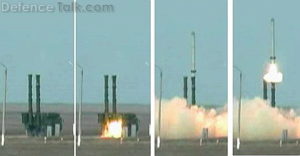
War is Boring:
Russia continues to rattle the United States with its alleged breach of a 1987 bilateral agreement aimed at eliminating medium-range ground-based missiles, according to a senior State Department official.
“We have made it very clear to our Russian colleagues that our patience is not indefinite,” said Frank Rose, the State Department’s top diplomat for arms control, compliance and verification. “We will work closely with our allies to ensure that Russia does not gain any benefit from its violation.”
Translation — this is bad. But unless Moscow actually deploys the prohibited missile, don’t expect a dramatic U.S. response anytime soon.
Congressional Republicans, who pushed the Obama administration three years ago to publicly acknowledge the treaty violation, won’t greet this news warmly. Neither will many arms-control advocates who call for treaty enforcement.
The United States in July 2014 formally accused Russia of breaking provisions in the Intermediate-range Nuclear Forces Treaty that ban either nation from building, flight-testing or possessing ground-based cruise missiles with ranges between 300 and 3,400 miles. Russian leaders deny they have violated the pact, commonly referred to as the INF agreement.
Washington has not publicly named the weapon at the focus of the controversy. But over the past two years, U.S. diplomats have dismissed theories that it’s a variant of an existing cruise missile, according to security experts. U.S. Defense and State Department officials say it appears Moscow has yet to deploy what they describe as the new “state-of-the-art” missile.
Russian flight tests of the ground-launched cruise missile are said to have already violated the pact, so the damage is done. But U.S. diplomats have been pressing the Kremlin to adhere to the INF terms going forward. They’re calling on Russia to stop any further development or flight tests, and prove that all nonconforming missiles and launchers are being destroyed.
“We have been in a very active engagement with the Russians over the past … three years to try to bring them back into compliance,” Rose said, speaking July 27, 2016 at a military symposium here. “To date, our efforts have not been successful. But we have not thrown in the towel.”
It’s a hard sell, U.S.-based Russia experts say.
If Moscow had wanted to adhere to international norms, it could have developed the missile only after withdrawing from the INF Treaty. Doing so, though, would have subjected the Kremlin to international opprobrium for exiting an agreement popular in Europe and Asia, where nations sit within range of ground-based missiles the accord was meant to eliminate, said Steven Pifer of the Brookings Institution.
Instead, Russia gambled on quietly developing a banned missile and exploiting Washington’s reluctance to discuss sensitive intelligence data about it. That reticence about revealing intelligence details hampers U.S. efforts to foster global opinion against the violation, Pifer said.
Last November, Rose said the Obama administration was contemplating “possible economic and military responses” that might “motivate Russia” to “resolve the issue diplomatically.” Others have since described U.S. and European economic sanctions against Russia — along with the NATO’s recent force buildups, new security collaborations and military exercises — as a substantial response to Moscow’s overall uptick in aggressive behavior, to include the prohibited cruise-missile testing.
Russia also has complicated the matter by floating counter-accusations that U.S. Aegis missile deployments in Romania violate the 1987 agreement. The United States denies this, saying Aegis is configured for use only in missile defense.
Onsite inspections would be required to prove the Aegis deployments could not be used as offensive ground-launched cruise missiles, said Ivo Daalder, a former U.S. ambassador to NATO. The Russian allegation is “invalid,” he said. But now that it “in the air,” the Aegis issue must be dealt with if Moscow’s breach is to be resolved, Daalder said.
Should the Kremlin move to deploy the prohibited weapon, the Pentagon has contemplated three possible response approaches. Fielding “active defenses” to protect allies against any cruise missile attacks. Using “counterforce capabilities” to strike the cruise missiles themselves on the ground. Or deploying “countervailing strike capabilities” akin to the Russian weapons.
Some of these options would comply with the INF Treaty, while others would not, Brian McKeon, a top Defense Department policy official, said in 2014 congressional testimony.
“In the event that Russia does deploy and it becomes obvious to the world that they have violated the treaty, then I’m confident that the administration will respond forcefully” with one or more of the three options, one former senior Pentagon official told War Is Boring. The individual spoke on condition of not being named, citing the sensitivity of reaction timing.
Each response category raises potential complications, though. Cruise missiles are relatively small and difficult to locate on the ground, and striking them could be highly inflammatory. These missiles also are hard to defend against in flight, Daalder noted. And the Pentagon can barely afford its existing equipment modernization plans without adding an expensive, new ground-based missile to the budget, Pifer said.
Should Moscow’s action compel Washington to openly develop new medium-range missile capabilities of its own, that could also put the White House — rather than the Kremlin — on the hot seat for withdrawing from the treaty first, Pifer said.
